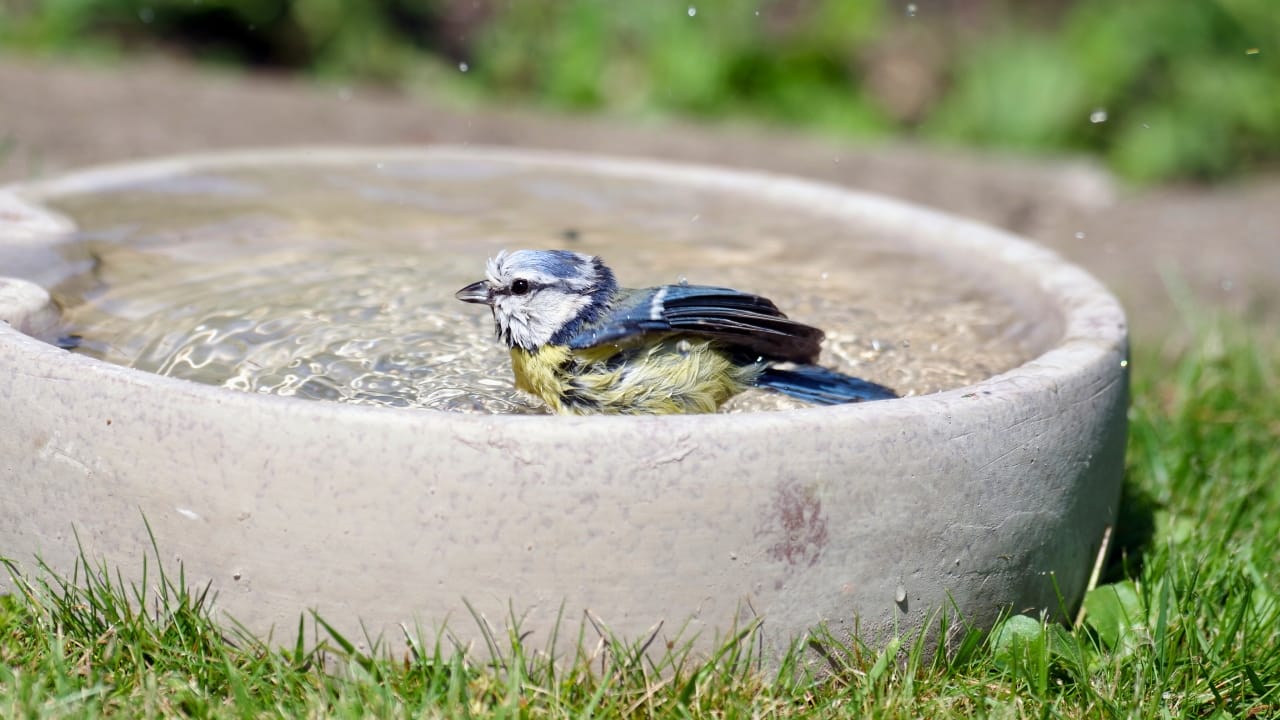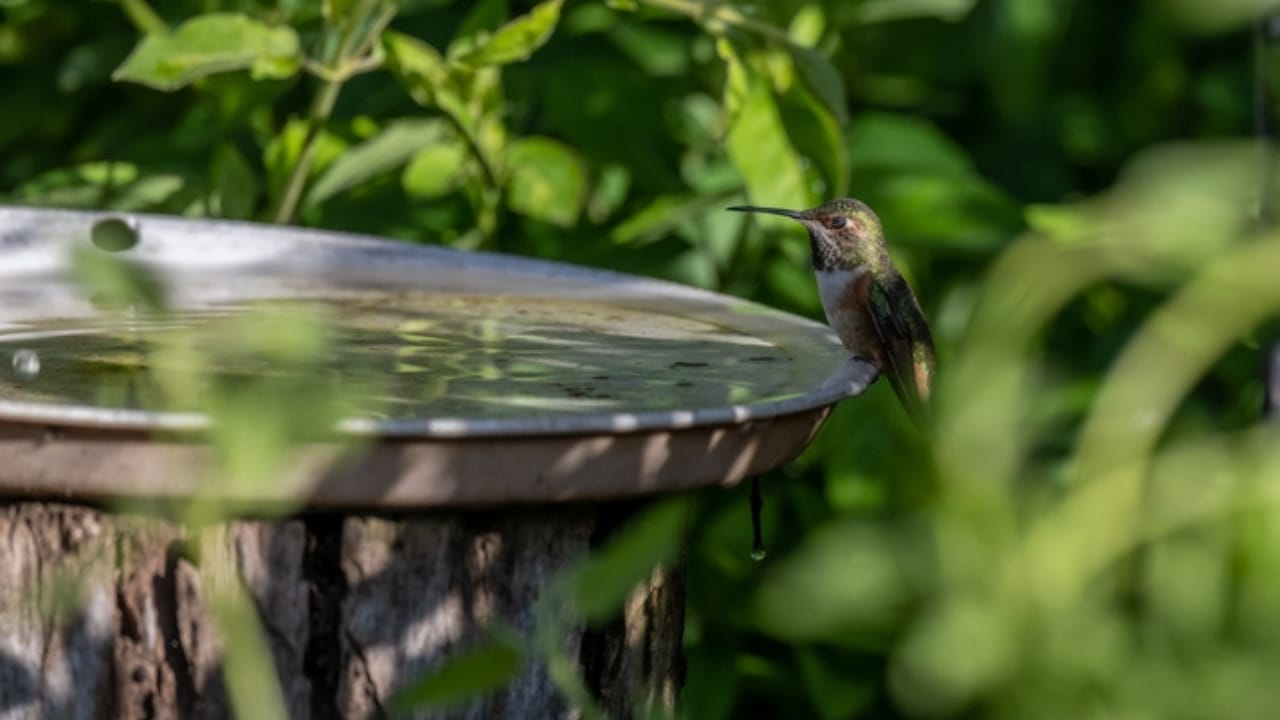Hummingbirds are delightful visitors to any garden. However, if you’ve noticed that these tiny birds are steering clear of your birdbath, it could be a sign that something is amiss.
Understanding why hummingbirds might avoid your birdbath is the first step toward making your garden a more inviting haven for them.
Here are common reasons behind their reluctance as well as practical solutions to address these issues.
Why Hummingbirds Avoid Your Birdbath

Here’s a detailed look at why hummingbirds might stay away from your birdbath:
1. Water Depth & Access
- Too Deep: Hummingbirds prefer shallow water. If your birdbath is too deep, it may not be accessible or safe for them. They need just a few inches of water to hover and drink, or occasionally to bathe.
- Lack of Perches: Hummingbirds need perches or landing spots near the water. A birdbath without any nearby places to rest or access the water might deter them.
2. Water Quality
- Stagnant Water: Stagnant water can become unappealing due to algae growth, odors, or contamination. Hummingbirds are sensitive to water quality and may avoid dirty or stagnant water.
- Chemical Residues: If the water in your birdbath contains any chemicals or is treated with cleaners, it could repel hummingbirds.
3. Water Movement
- Lack of Movement: Hummingbirds are attracted to moving water. A static birdbath without any movement may not catch their attention.
- Intense Movement: Conversely, excessive water movement from fountains or mist systems could be intimidating.
4. Birdbath Design & Location
- Design Issues: The design of the birdbath might not suit hummingbirds. For example, a birdbath with steep sides or an unfamiliar shape could be less inviting.
- Location Problems: The birdbath’s location might be too exposed or lacking in cover. Hummingbirds prefer a more sheltered area where they feel safe from predators.
5. Competing Attractions
- Other Food Sources: If there are more appealing food sources like nectar feeders nearby, hummingbirds might prefer those over the birdbath.
- Predator Presence: If there are predators or disturbances around the birdbath, hummingbirds may stay away due to safety concerns.
6. Seasonal & Environmental Factors
- Temperature Extremes: Extremely hot or cold weather can affect how birds use the birdbath. In very hot weather, they might prefer cool, shaded areas, while in cold weather, they might avoid the birdbath due to freezing conditions.
How to Improve A Regular Birdbath With Stones

Adjust the water level by adding stones to create shallow areas and ensure there are safe places for them to perch around the bath.
Here’s how you can enhance your birdbath with stones:
1. Add Texture & Grip
- Place Flat Stones in the Basin: Adding flat stones to the bottom of the birdbath provides birds with a textured surface to land on. This is especially important for smaller birds that might find it difficult to grip smooth surfaces.
- Create Safe Landing Spots: By arranging stones of different sizes, you can create various levels and textures. This helps birds feel secure as they can choose spots where they feel comfortable.
2. Provide Shallow Areas
- Layer Stones to Create Depth Variations: Use stones to build up certain areas, creating shallow spots in the birdbath. Birds prefer shallow water because it’s easier to access and less likely to be dangerous.
- Ensure a Gradual Slope: Arrange the stones so that there’s a gradual slope leading into deeper water. This allows birds to wade in and out safely.
3. Enhance Aesthetics & Natural Look
- Choose Natural Stones: Opt for stones that blend well with your garden or natural surroundings. River rocks or flat stones often look more natural than synthetic materials.
- Create a Rock Garden Effect: Arrange the stones to mimic a natural water feature. This can attract more birds by making the birdbath look like a part of their natural habitat.
4. Improve Water Quality
- Use Stones to Promote Water Circulation: Placing stones in strategic locations can help with water circulation, reducing stagnation. This is particularly helpful in keeping the water fresher and more appealing to birds.
- Add a Submersible Pump: If you want to go a step further, consider adding a small submersible pump. It can circulate the water and make the birdbath more attractive to birds.
5. Ensure Easy Maintenance
- Choose Smooth Stones: Opt for stones that are easy to clean. Avoid stones with rough surfaces that might trap debris.
- Regular Cleaning: Stones can trap algae and other debris, so regular cleaning is essential. Remove the stones periodically to scrub them and clean the birdbath.
6. Consider Safety
- Avoid Sharp Edges: Ensure that the stones used have no sharp edges that could harm the birds.
- Stable Placement: Make sure the stones are securely placed and won’t shift or move, which could cause accidents.
Traditional Birdbath Alternatives

These alternatives to the traditional birdbath can provide birds with unique and appealing ways to drink and bathe. Here are two popular options:
1. Mist System
A mist system provides a fine, gentle spray of water, mimicking natural dew or rain. This method is particularly attractive to birds that enjoy bathing in light mist.
Benefits
- Cooling Effect: The mist can be especially refreshing during hot weather, offering a cool respite for birds.
- Attracts Various Species: Many birds are drawn to mist systems because they offer a different experience from traditional birdbaths.
- Low Maintenance: Mist systems often require less frequent cleaning compared to traditional birdbaths since the water is constantly moving.
How to Implement
- Install a Mist Kit: You can purchase a misting kit designed for birdbaths or garden use. These kits typically come with a nozzle and tubing.
- Position Wisely: Place the mist system where birds are likely to visit, such as near trees or shrubs that provide cover and safety.
- Adjust the Spray: Ensure the mist is gentle enough not to overwhelm or scare the birds. It should create a light, refreshing spray.
2. Slow Drip (Small Fountain)
A slow drip system, often resembling a small fountain, provides a steady but gentle flow of water. This method can attract birds with its continuous water source and soothing sound.
Benefits
- Constant Water Supply: The slow drip ensures a steady supply of fresh water, which is attractive to birds for drinking and bathing.
- Soothing Sound: The gentle sound of dripping water can attract birds and create a calming garden environment.
- Encourages Bird Interaction: Birds may be more likely to interact with a slow drip fountain, as the moving water can catch their attention.
How to Implement
- Choose a Fountain Design: Opt for a small, bird-friendly fountain designed to be easy for birds to use. Look for models with shallow basins and gentle water flow.
- Ensure Easy Access: Position the fountain in a location that’s accessible to birds but not too close to potential predators.
- Maintain the Fountain: Regularly clean the fountain to prevent algae growth and keep the water fresh.
For both mist systems and slow drip fountains, placement is key. Ensure the setup is visible to birds and located in a safe, sheltered area. Also, keep the systems clean and check for any issues to ensure they function properly and continue to attract birds.
Nancy has been a plant person from an early age. That interest blossomed into a bachelor’s in biology from Elmira College and a master’s degree in horticulture and communications from the University of Kentucky. Nancy worked in plant taxonomy at the University of Florida and the L. H. Bailey Hortorium at Cornell University, and wrote and edited gardening books at Rodale Press in Emmaus, PA. Her interests are plant identification, gardening, hiking, and reading.

